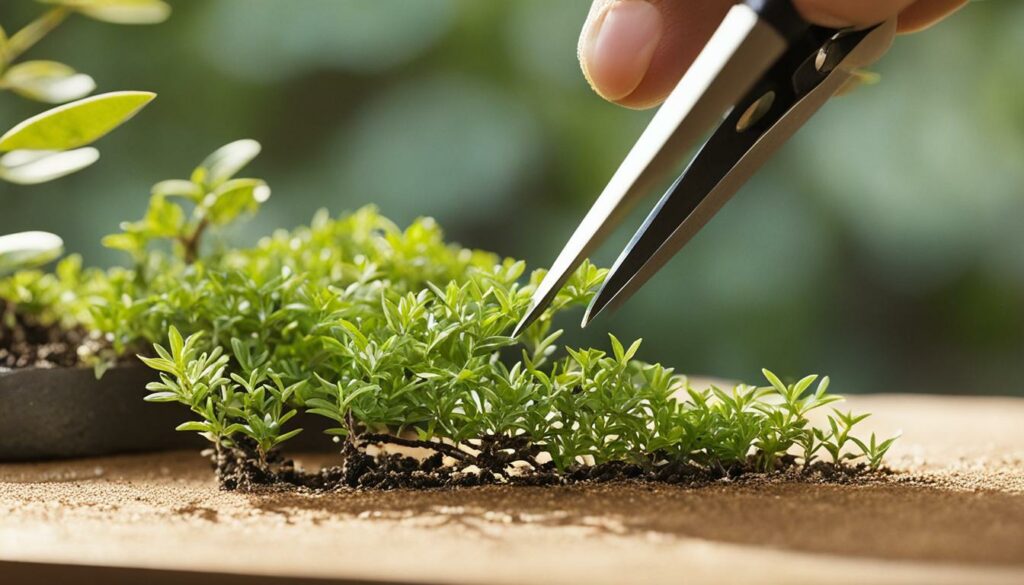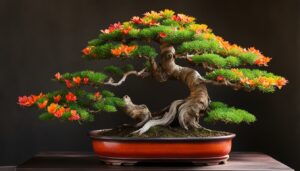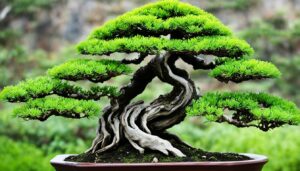Are you looking to create a serene and balanced aesthetic for your miniature trees? Bonsai styling leaf trimming and shaping should be at the top of your list. Trimming and shaping the leaves of your bonsai allows you to create a well-balanced and eye-catching display.
In this section, we will explore the techniques that go into perfecting the trimming and shaping of bonsai leaves. Discover expert tips that will help you cultivate the perfect look for your miniature trees.
Whether you’re a seasoned bonsai grower or just getting started, mastering the art of leaf trimming and shaping is essential for achieving a beautiful and balanced bonsai display.
Key Takeaways:
- Trimming and shaping bonsai leaves is crucial for creating a well-balanced and eye-catching display.
- Expert techniques can help you cultivate the perfect look for your miniature trees.
- Mastering the art of bonsai leaf trimming and shaping is essential for achieving a beautiful and balanced bonsai display.
- Be patient and practice consistently to enhance your skills over time.
- Adapt your approach based on the specific needs of each bonsai species.
Understanding Leaf Size Reduction in Bonsai Styling
If you want to achieve the perfect proportions for your bonsai, understanding leaf size reduction is key. Large leaves can detract from the beauty of your miniature tree, making it look disproportionate and unappealing. By reducing the size of the leaves and creating a more natural scale, you can elevate the overall aesthetic of your bonsai.
Leaf size reduction is particularly important for bonsai styling, where every detail is amplified by the tree’s small size. By reducing the leaf size, the visual focus of the bonsai will shift from the foliage to the entire tree. The tree’s shape, size, and trunk movement will become more noticeable, creating a serene and harmonious composition.
There are several techniques to achieve smaller leaves, such as:
- Pruning: Removing a portion of the leaf or the entire leaf to stimulate new growth and force the tree to produce smaller leaves. Timing is critical, and it’s essential to avoid over-pruning, which can undermine the tree’s health.
- Wiring: Wires can be used to restrict nutrient flow to larger leaves, which will stimulate the tree to create smaller leaves.
- Pinching: To maintain the shape of the tree and its natural size, pinch the growing tips of the leaves when they reach the desired size, which will encourage smaller leaves to grow instead.
With careful practice and attention to your tree’s specific needs, you can improve your bonsai styling skills and achieve a more harmonious and balanced composition.
Canopy Shaping: Creating Beautiful Bonsai Silhouettes
Canopy shaping is the art of sculpting the foliage of your bonsai to create beautiful and balanced silhouettes. It is an important aspect of bonsai styling, as it contributes to the overall aesthetic and impact of your miniature tree.
There are several techniques you can use to shape the canopy of your bonsai:
- Pruning: Removing certain branches to create the desired shape and form.
- Wiring: Using wire to bend and position branches in a specific way.
- Leaf Cutting: Removing certain leaves to shape the overall canopy and achieve a more balanced look.
It is important to have a clear vision of what you want to achieve with your canopy shaping before starting. Look for inspiration in nature, other bonsai designs, or simply let your creativity guide you. Keep in mind that each bonsai species has its own unique growth patterns and requirements, so research your specific species and adjust your approach accordingly.
“Canopy shaping gives you endless possibilities to create unique and stunning bonsai designs that showcase the beauty and balance of nature.” – John Yoshio Naka
| Technique | Pros | Cons |
|---|---|---|
| Pruning | Allows for more precise shaping and control over the bonsai’s growth pattern. | Can be time-consuming and may require frequent maintenance to maintain the desired shape. |
| Wiring | Provides immediate results and allows for more complex shapes and forms. | Improper wiring can damage or even kill your bonsai, so it must be done with caution and knowledge. |
| Leaf Cutting | Allows for subtle adjustments in the overall canopy shape and can create a more balanced look. | May require frequent cutting and can potentially harm the overall health of your bonsai if done improperly. |
Remember to always prioritize the health and well-being of your bonsai when shaping the canopy. Do not overdo it and only use techniques that are appropriate for your bonsai’s specific needs and growth patterns.
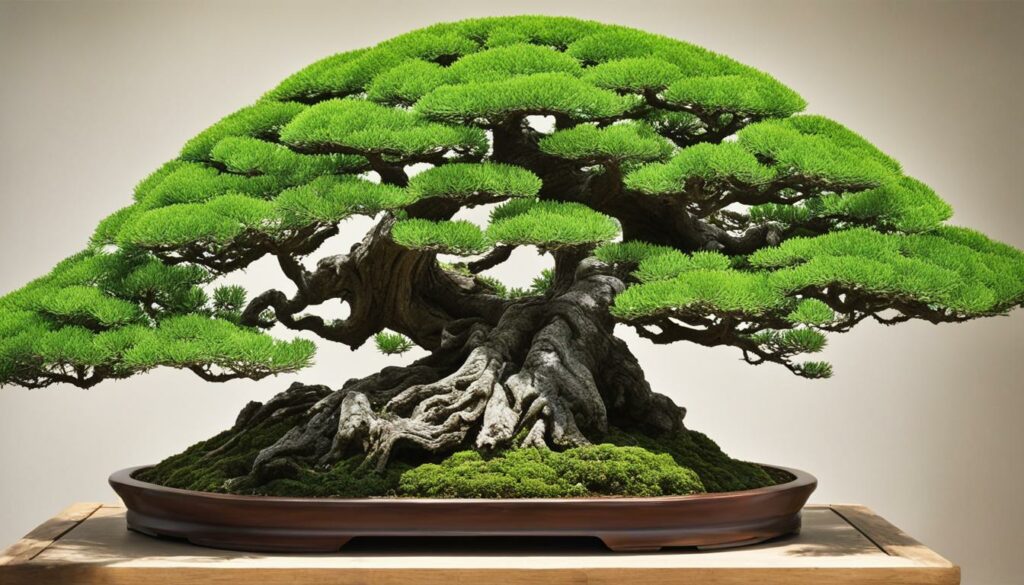
Foliage Styling: Enhancing Your Bonsai’s Visual Appeal
Styling the foliage of your bonsai to enhance its visual appeal is an essential aspect of bonsai styling. By positioning the leaves strategically, you can create depth, texture, and balance in your design. Here are some expert techniques to help you achieve stunning foliage styling.
1. Alternating Leaf Direction
Alternate the direction of the leaves along the branches to create visual interest in your design. This technique applies to both single and multiple leaf nodes and is particularly effective in group plantings. It creates the illusion of natural randomness, making your bonsai more realistic and visually appealing.
2. Varying Leaf Sizes
Varying leaf sizes can create a sense of depth in your bonsai, especially in group plantings. Place larger leaves in the foreground and smaller leaves in the background to give your miniature trees the appearance of a larger ecosystem. This technique requires some experimentation to achieve the right balance, so be patient and keep practicing.
3. Angling Leaves for Texture and Depth
Angling bonsai leaves creates visual texture and depth in your design by casting shadows on one another. Experiment with different angles to create the desired effect. You can also wire the branches to create the desired leaf angle. Be gentle when bending the branches to prevent damage to the tree.
4. Layering Foliage
Layering foliage involves positioning leaves to create the appearance of depth and dimensionality in your bonsai. Use larger and flatter leaves as a base and stack small and compact leaves on top, angling them to create a three-dimensional look. This technique is effective for creating the appearance of a mature, well-established bonsai.
Remember that each bonsai species has unique foliage characteristics that require specific techniques to enhance their visual appeal. Experiment with different styling techniques to find the right one for your miniature trees. And always be mindful of maintaining leaf health during the styling process to promote overall bonsai vitality.
Tools and Techniques for Bonsai Leaf Trimming and Shaping
Effective bonsai leaf trimming and shaping heavily rely on having the right tools to work with. As such, it is important to have a good understanding of the available tools and the techniques required to make precise cuts. Here are some of the tools that may come in useful for leaf trimming and shaping:
| Tool | Description |
|---|---|
| Bonsai Scissors | Designed specifically for bonsai work, these scissors come in different shapes and sizes to suit your needs. |
| Branch Cutters | Ideal for trimming larger branches and twigs that are too thick for scissors. |
| Wire Cutters | Used for cutting wire that has been wrapped around the tree branches to shape them. |
| Concave Cutters | Specialized cutters designed to leave a concave dip when trimming branches, making it easier for the bark to cover the cut wound and heal faster. |
| Grafting Knife | Used for grafting purposes when introducing new branches to a bonsai tree. |
When it comes to techniques, here are some common methods that you may find useful:
- Leaf Pinching: This involves using your fingers to pinch off certain parts of the leaves to promote new growth or control the size and shape of the leaves.
- Clip and Grow: A technique used to shape the branches of a tree by clipping them back and allowing them to regrow in the desired direction.
- Wiring: Involves wrapping wire around the branches to bend and shape them into position.
- Pruning: An essential technique used to remove unwanted branches, twigs, and leaves to create or maintain the desired shape or size of the bonsai tree.
Remember, choosing the right tool and technique for your bonsai tree will depend on the species, size, and desired shape. Always ensure that your tools are clean and sharp to avoid damaging the tree. With practice and patience, you will soon master the art of bonsai leaf trimming and shaping.
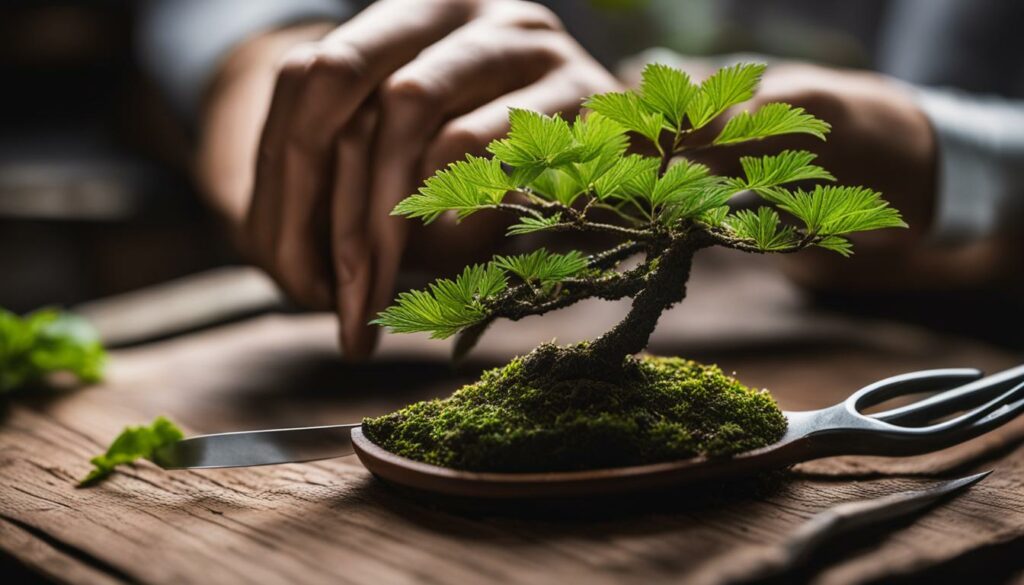
Understanding the Growth Patterns of Bonsai Leaves.
When it comes to bonsai styling, understanding the growth patterns of bonsai leaves is crucial. It can greatly affect your pruning and styling decisions. Bonsai leaves typically grow in specific patterns, which can be categorized into two types: alternating and opposite.
Alternating leaves grow on the stem in a staggered pattern, with each leaf emerging from a slightly different point. This pattern creates a more natural and relaxed look, which is suitable for most bonsai styles.
Opposite leaves, on the other hand, emerge from the stem in pairs, with each pair located across from each other at the same height. This pattern creates a more formal and symmetrical look, suitable for certain bonsai styles such as formal upright and informal upright.
It’s important to identify the growth patterns of your bonsai leaves before pruning and styling. This will help you to work with the natural growth patterns of your tree and create a more cohesive and balanced overall design.
Pruning Techniques for Leaf Reduction
To achieve leaf size reduction in bonsai, pruning is a crucial technique. The art of pruning involves cutting back the branches and foliage of your bonsai to control its growth and shape. With the right pruning techniques, you can achieve the desired leaf size and overall aesthetic of your miniature tree.
When pruning for leaf reduction, it’s important to consider the timing and frequency of your pruning. You should prune your bonsai during its active growing season, which varies depending on the species. Frequent pruning throughout the growing season can help promote smaller leaves and maintain the desired shape.
One key technique for leaf reduction is called node pruning. This involves cutting back to the first or second node on a branch, which will encourage new growth closer to the trunk and smaller leaves.
Another technique is called partial defoliation, where you remove only some of the leaves from a branch to encourage the growth of smaller replacement leaves. This technique should be used judiciously, as it can be stressful for the bonsai.
It’s important to use the right tools for pruning to ensure a clean and precise cut. Bonsai pruning shears and scissors are designed for precision cutting and can help prevent damage to your bonsai.
By mastering the art of pruning, you can achieve the perfect leaf size and shape for your bonsai tree. Experiment with different techniques and take the time to perfect your pruning skills to create beautiful and balanced bonsai designs.
Wiring for Leaf Shaping
Wiring plays a crucial role in shaping the branches and leaves of your bonsai. By bending the branches and leaves in the desired direction, you can create intricate and beautiful shapes that enhance the overall aesthetic of your bonsai. However, it is essential to wire carefully, as improper wiring can cause damage to the delicate branches and leaves.
To properly wire your bonsai, you will need a pair of bonsai wire cutters and a roll of bonsai wire. Begin by choosing a wire that is roughly 1/3 the diameter of the branch or leaf you wish to wire. For delicate branches and leaves, use a thinner wire to prevent damage.
Starting at the base of the branch or leaf, wind the wire around the bonsai tightly at a slight angle, making sure to avoid any existing buds or leaves. Then, gently bend the branch or leaf in the desired direction, taking care not to over-bend or cause any damage.
Remember to remove the wire once the branch or leaf has set in place to prevent any unnecessary damage. It is also essential to check the wiring regularly, as the wire can begin to cut into the branch or leaf if left on for too long.
Tip: Never wire the same branch or leaf more than once in a growing season, as this can cause severe damage to the bonsai.
With proper wiring techniques, you can shape your bonsai leaves into beautiful and intricate designs that will enhance its overall visual appeal.
Pinching Techniques for Fine-Tuning Bonsai Leaves
Pinching is a useful technique for maintaining the size and shape of bonsai leaves. With this method, you use your fingers to remove the small, newly formed leaves that appear at the tips of branches. Pinching encourages the growth of backbuds, which produce smaller leaves that are better suited to bonsai styling.
To use the pinching technique, find the emerging leaves at the tip of each branch and simply remove them with your fingertips. Be sure to remove the entire leaf, including the stem, to avoid damaging the branch. Pinching new growth frequently will stimulate the growth of smaller leaves and keep your bonsai’s appearance in check.
One thing to keep in mind is that not all bonsai species respond well to pinching. Some species may develop unsightly growth patterns if pinched too much or too frequently. Others may not produce backbuds as readily, making it difficult to maintain the desired leaf size and shape. Be sure to research the specific needs of your bonsai species before attempting to use pinching as a pruning technique.
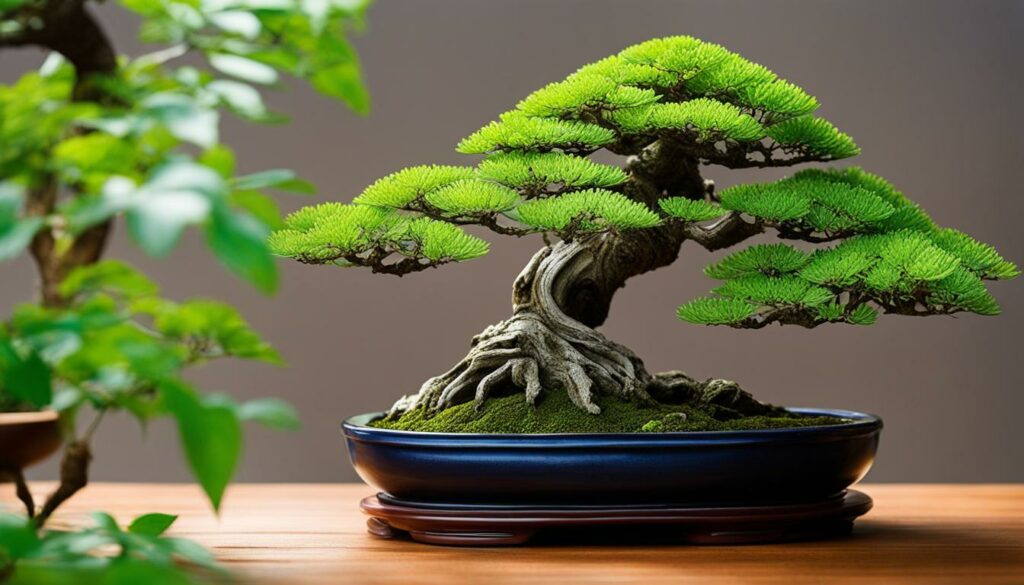
Remember: Pinching is a great way to fine-tune your bonsai’s appearance. With practice, you can use this technique to control the size and shape of your bonsai’s leaves, creating a more refined and balanced aesthetic.
Leaf Cutting for Canopy Shaping
If you want to shape the canopy of your bonsai, leaf cutting is an essential technique you need to employ. By removing leaves in strategic locations, you can create a more refined and balanced silhouette. To get started with leaf cutting, you will need sharp scissors or pruning shears and a steady hand.
Begin by identifying the areas where you want to remove leaves. These should be areas where leaves are overgrown or crowding the space. Use your scissors or pruning shears to carefully snip off the leaves, making sure not to damage any surrounding branches or foliage.
It’s important to note that removing too many leaves at once can be stressful for your bonsai. Instead, aim to remove a few leaves at a time and monitor the tree’s response. If it appears to be struggling, reduce the amount of leaf cutting until it has recovered.
Leaf cutting can be especially effective for trees with large leaves, such as Ficus or Ginkgo. By strategically removing leaves, you can create a more aesthetically pleasing and proportionate canopy for your bonsai.
Maintaining Leaf Health during Trimming and Shaping
Trimming and shaping are essential techniques to cultivate a beautiful bonsai. However, it can directly impact the health of its leaves. While conducting bonsai trimming and shaping, the utmost care must be taken to ensure the health of the leaves is maintained.
Each cut or trim must be deliberate, ensuring no damage is caused. Avoid cutting too close to the leaf base, as it can result in excessive scarring, which can result in diseased or dead leaves. Also, ensure your tools are cleaned and sanitized before use to avoid spreading disease and infection between plants.
An additional way to maintain the health of your bonsai leaves is to keep a watchful eye out for insect infestation. If detected early, use neem oil, a natural insecticide or an insecticidal soap to combat pests without damaging the leaves.
Moreover, to maintain the health of your leaves, it is essential to select the appropriate pruning time. Choose a time when the bonsai tree has full leaf health and is in its active growth stretch. This ensures that you can undertake bonsai trimming and shaping without endangering the health of the bonsai plant.
By adhering to these leaf maintenance guidelines, you can maintain the health and longevity of your bonsai tree.
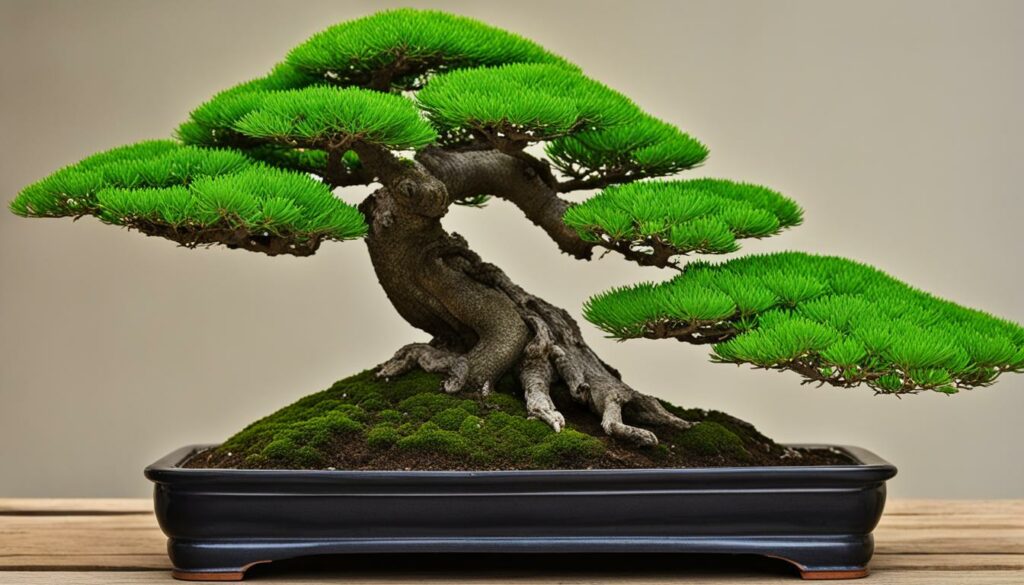
Species-specific Considerations for Leaf Styling
Bonsai leaf styling requires specialized techniques and approaches that can vary by species. When considering leaf styling, it is essential to keep the unique attributes of each bonsai species in mind. Species-specific considerations can help you achieve optimal leaf styling and maintain the health of your bonsai.
For instance, some species have leaves that are naturally smaller and require less pruning, while others have larger leaves that need to be reduced in size. Additionally, some species benefit from pruning and styling during specific times of the year, while others can be trimmed and shaped throughout the year.
When styling bonsai leaves, it is also important to consider the overall aesthetic and character of the species. Different species have distinctive leaf shapes, textures, and colors that can be enhanced or detracted from depending on how they are styled. Therefore, it is essential to learn about the unique features of each species and adjust your styling techniques accordingly.
Species-specific Leaf Styling Considerations
| Bonsai Species | Considerations for Leaf Styling |
|---|---|
| Juniper | Prune young foliage during spring and early summer. Use scissor-cutting techniques to shape and thin out foliage. Avoid targeting old foliage. |
| Pine | Perform decandling in late spring. Prune young growth in late winter. Use pinching and cutting techniques to shape foliage. Avoid pruning old needles. |
| Maple | Perform trimming and shaping during winter and early spring. Use scissor-cutting techniques to reduce leaf size. Avoid pruning during summer and fall. |
| Elm | Use directional pruning to encourage leaf reduction. Shape foliage during late winter or early spring. Avoid pruning in the middle of summer. |
By taking the time to understand species-specific leaf styling techniques, you can enhance the health and beauty of your bonsai. Remember to research each species thoroughly and adjust your approach accordingly to achieve optimal results.
Timing and Frequency of Leaf Trimming and Shaping
Proper timing and frequency are crucial when it comes to leaf trimming and shaping in bonsai. Understanding when to perform these tasks can mean the difference between a healthy, thriving bonsai and one that struggles to grow.
The optimal time to trim and shape your bonsai leaves depends on the specific species and the desired goal. In general, it is best to perform leaf trimming in the spring and summer when the plant is actively growing. This will give your bonsai the best chance to quickly recover and adjust to the pruning.
When it comes to frequency, it is important not to over-prune your bonsai. Trimming too often or removing too many leaves at once can cause stress and hinder growth. A good rule of thumb is to trim your bonsai every 2-4 weeks during the growing season, ensuring not to remove more than 20-30% of the leaves at a time.
Summary Table: Timing and Frequency of Leaf Trimming and Shaping
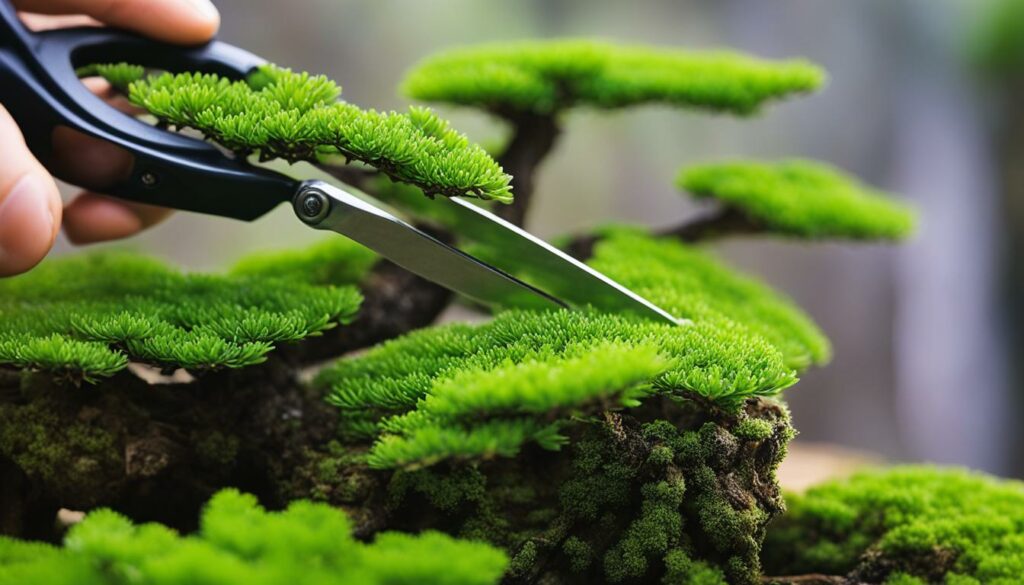
| Bonsai Species | Optimal Time for Leaf Trimming | Frequency of Leaf Trimming | Percentage of Leaves to be Trimmed |
|---|---|---|---|
| Conifers | Spring and Summer | Every 2-4 weeks | 20-30% |
| Deciduous Trees | Spring and Summer | Every 2-4 weeks | 20-30% |
| Tropical Trees | Throughout the Year | Every 2-4 weeks | 20-30% |
Keep in mind that timing and frequency are not the only factors to consider when it comes to leaf trimming and shaping. It is also important to use the proper tools and techniques to ensure healthy growth and development of your bonsai. With practice and patience, you can master the art of trimming and shaping bonsai leaves to create stunning creations that bring tranquility to any space.
Patience and Practice: Keys to Mastering Bonsai Leaf Trimming and Shaping
Mastering the art of bonsai leaf trimming and shaping takes time and effort, but with patience and practice, anyone can achieve beautiful results. As you begin your bonsai journey, keep in mind that each tree requires a unique approach that takes into consideration its species, growth patterns, and overall health.
Start by familiarizing yourself with the tools and techniques used for bonsai leaf trimming and shaping, such as scissors, branch cutters, and wiring. Remember that every cut and pinch impacts the growth and appearance of your bonsai, so it’s important to proceed with caution.
As you gain experience, you’ll develop a better understanding of the timing and frequency of leaf trimming and shaping. For example, some species may require more frequent trimming, while others may thrive with less frequent attention.
Throughout your bonsai trimming and shaping journey, it’s important to have patience and not rush the process. Rushing can result in damaged leaves and branches, negatively impacting the overall health of your bonsai. Take the time to carefully plan your approach, and be willing to adjust your methods as needed.
“Bonsai is not a form of art that you can purchase or realize in one day. It needs time, love, knowledge, and patience.” – Walter Venne
In addition, practice is key to mastering bonsai leaf trimming and shaping. The more you work with your bonsai, the more comfortable and skilled you will become in achieving your desired results.
Remember that bonsai leaf trimming and shaping is an ongoing process that requires ongoing attention and care. Stay consistent in your efforts, and don’t be afraid to seek guidance from experienced bonsai enthusiasts or professionals.
So, with patience and practice, you can become a master of the art of bonsai leaf trimming and shaping. Take the time to develop your skills, and enjoy the beauty and serenity that bonsai trees can bring to your life.
Conclusion
In conclusion, perfecting the art of bonsai leaf trimming and shaping requires patience, practice, and a willingness to learn. With the techniques and strategies outlined in this article, you can create beautiful and serene bonsai creations that bring joy to any space.
Remember to consider the species-specific considerations for each bonsai, use the proper tools and techniques for each task, and maintain leaf health during trimming and shaping. Timing and frequency are also key considerations when it comes to performing these tasks.
Most importantly, don’t be discouraged if your first attempts are not perfect. Patience and practice are essential to mastering the art of bonsai styling. Keep learning, keep practicing, and soon you will be creating stunning bonsai designs that bring tranquility and beauty to your surroundings.
FAQ
Why is leaf size reduction important in bonsai styling?
Leaf size reduction is important in bonsai styling because it helps create a more proportionate and balanced look for the miniature trees. Smaller leaves create the illusion of a mature tree in a small scale, enhancing the overall aesthetic of the bonsai.
How can I achieve leaf size reduction in my bonsai?
Leaf size reduction can be achieved through regular pruning and pinching techniques. By selectively removing larger leaves and encouraging the growth of smaller leaves, you can gradually reduce the size of the foliage over time.
What is canopy shaping in bonsai?
Canopy shaping in bonsai refers to the process of sculpting and shaping the foliage to create a desired silhouette or form. It involves carefully wiring and positioning branches and leaves to create balanced and visually appealing bonsai designs.
How can I shape the canopy of my bonsai?
To shape the canopy of your bonsai, you can use wiring techniques to position and manipulate the branches and leaves. By carefully wiring the branches into desired positions and shaping the foliage, you can create the desired silhouette and form for your bonsai.
What is foliage styling in bonsai?
Foliage styling in bonsai involves arranging and positioning the leaves to enhance the visual appeal of the tree. It focuses on creating depth, texture, and balance through proper foliage arrangement and styling techniques.
How can I style the foliage of my bonsai?
To style the foliage of your bonsai, you can use techniques such as defoliation, leaf cutting, and pinching. These techniques allow you to create depth, texture, and balance by selectively removing or manipulating the leaves to create the desired visual effect.
What tools and techniques can I use for bonsai leaf trimming and shaping?
There are various tools and techniques available for bonsai leaf trimming and shaping. Tools such as scissors, branch cutters, and wire cutters are commonly used. Techniques include pruning, pinching, wiring, and leaf cutting, each serving a specific purpose in achieving the desired leaf shape and size.
How can I maintain leaf health while trimming and shaping my bonsai?
To maintain leaf health during trimming and shaping, it is important to use sharp and clean tools to minimize damage. Additionally, ensure proper watering, fertilization, and maintenance practices to promote overall bonsai vitality and minimize stress on the leaves.
Are there species-specific considerations for bonsai leaf styling?
Yes, different bonsai species may have specific considerations when it comes to leaf styling. Some species may have naturally smaller or larger leaves, while others may require specific techniques or approaches. It is important to research and understand the specific needs of each bonsai species to achieve optimal leaf styling results.
What is the timing and frequency for leaf trimming and shaping?
The timing and frequency for leaf trimming and shaping can vary depending on the specific needs of your bonsai species. As a general rule, it is best to perform leaf trimming and shaping tasks during the growing season to allow the tree to recover and promote healthy growth. The frequency will depend on how quickly the leaves grow back and the desired shape and size you wish to achieve.
How important is patience and practice in bonsai leaf trimming and shaping?
Patience and practice are key to mastering the art of bonsai leaf trimming and shaping. It takes time to develop the skills and techniques needed to create the desired results. By consistently practicing and adapting your approach based on the specific needs of each bonsai, you can steadily improve and achieve stunning leaf styling results.
